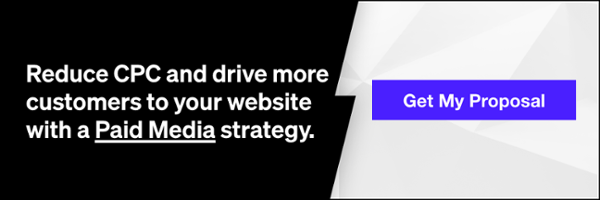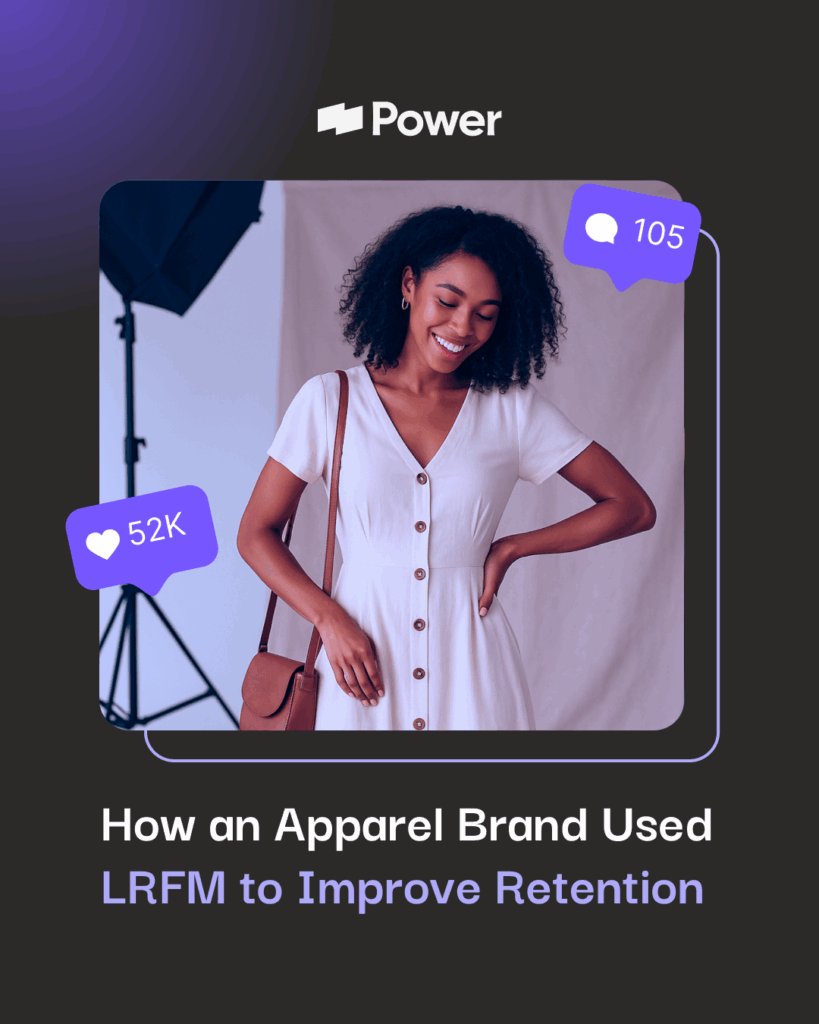Mobile traffic has been on a colossal rise and this trend is only going to continue. With all the additional volume, it’s no question that mobile advertising is absolutely imperative to the search strategy in play within your accounts. The goal as search marketers is to display ad creative that will resonate with our targeted audiences and lead them to our desired outcomes.
With that being said, mobile ad creative versus desktop and other devices is by no means synonymous with one another. Mobile ad creatives should be treated distinctly from other devices in order to maximize the performance of your campaigns. Let’s dive into some best practices to help scale your mobile ads and generate the best results for your clients.
Keep It Simple
There’s a high chance your mobile audience may be on the go or quickly browsing for whatever solution it is they need. You want your ad creative to be easily digestible so your value can be expressed without a big investment in the consumer’s time. Not only are consumers’ attention spans shorter than ever, but there is less and less real estate available on ads for lengthy texts or cluttered images. With this in mind, here are two ideas to help you clarify your message, and capture and engage your audience.
Keep your message clear and straightforward
Generally speaking, if it takes a user more than three-seconds to understand your mobile ad message, then you’ve lost them. Appeal to their short attention spans with thoughtful, engaging and powerful visuals, as well as straightforward text that captures their attention right away. If you’re using video ads, appeal to the user’s visual senses and connect with their emotions. If it’s a native ad, use captivating imagery and language to help them resonate with your ad.
Related: Top Facebook Advertising Hacks
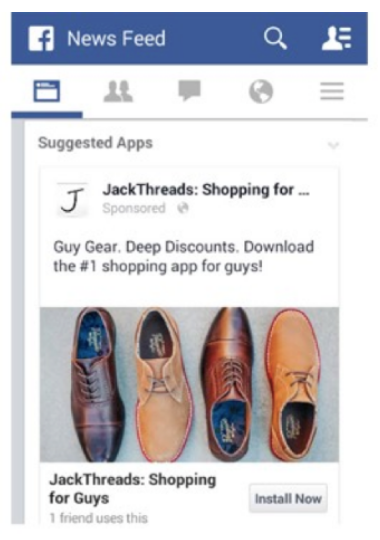
The screen capture of JackThread’s Facebook ad below is a fine example of a simple, clear and compelling messaging. The first two words tell us immediately who this is for and why this demographic needs to pay attention. The next two words offer an incentive: Deep discounts. Finally, the last sentence conveys how men can buy gear at a great discount with a call to action (more on that later). Notice how short and sweet this ad is, and how quickly we can decipher who it targets, the benefits to its audience, and how they can get guy gear at a discounted price.
Make use of multi-touch capabilities
Mobile dating apps like Tinder and Bumble were among the first to take advantage of mobile’s swipe functionality, making the app interactive and addictive to users. Taking a page out of their playbook wouldn’t hurt mobile ad developers. Allow users to engage with your mobile ad using swipe, tilt, pinch, or click — anything that makes it more entertaining, useful, or easy for your target demographic.
Create A Sense Of Urgency
Nothing says “I need this right now” quite like a false sense of urgency, and that’s exactly what you want to convey in your mobile app. You’ll want your audience to take immediate action for the fear of missing out on something great, like a steep discount, early bird prices, limited edition samples or a chance to win a prize. This ties back to the idea of your mobile audience being on the go and looking for a fast solution.
Creating urgency ties back to behavioral psychology, which dictates that an individual will behave rashly or suspend sound judgment if he or she feels there’s a limited time to act. This is why we see infomercials tell audiences to “act now” or “within the next ten minutes” if they want to receive bonuses with their purchase. In mobile advertising, human nature plays out the same way. We have to create scarcity, time-sensitivity or even competition to urge consumers to act quickly.
Related: The State of Mobile Advertising in 2017
Here’s how Southwest Airlines recently created a sense of urgency with one of its ads.
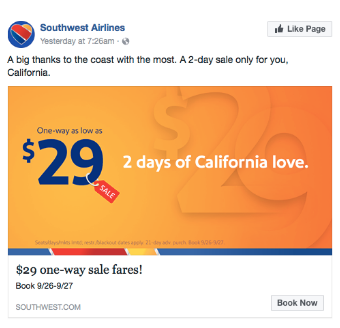
First, the popular airline points to the time-sensitivity of its ad by promoting a two-day sale within the text. Next, the image plays to the individual’s emotions by highlighting a trip of“California love.” Finally, SouthWest conveys its sense of urgency more with a subtle “book now”call-to-action and by inserting additional text that reads “Book 9/26-9/27”. It doesn’t hurt that a bold $29 price tag dominates the ad space. Anyone looking for deals to California are likely to stop and book with this ad.
Retailers are also great examples of those doing mobile ads well. Companies like Nordstrom, Gilt, or GameStop might include a special promotion, limited edition items or access to online sample sales within their ads to convert consumers into buyers.
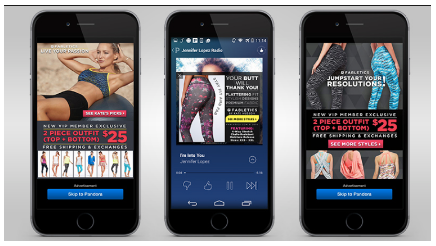
Fabletics, the women’s athletic apparel brand by actress Kate Hudson, offers first-time users a chance to buy a two-piece outfit for $25 upon signing up as a VIP member. The promotion exists on the Fabletics website too, but if users are browsing for yoga pants on their mobile device while waiting around at the airport, this is a clever way to incentivize them to shop right then and there.
Keep Location Top Of Mind
Chances are that your mobile audience is just that, mobile. This provides a great opportunity to customize your ads to the specific location that they are in. According to Pew Research, 73 percent of 18 to 29-year-olds use their smartphones to browse and shop online. Retailers, for example, can use consumer’s geographical location to promote sales from shops within the area. Advertisers can also use location to drive traffic to actual brick-and-mortar stores with a limited time offer like “free coffee with purchase” if they know a user stopped at a local coffee shop earlier that morning.
Adapting to the context of users’ location is also key. Say that you’re browsing for bikinis while hanging out in a coffee shop in Denver, CO in the middle of January. Chances are you’re going on a tropical vacation and in need of warm weather clothing and beachwear. Smart marketers and advertisers know that sending you an ad for ski boots is a waste of budget, but you’re more likely to buy something if presented with an ad for sunglasses. Contextual advertising is personal, timely, and respectful to the end user while being a better use of the advertiser’s budget and time.
Use Appropriate Call-To-Actions
Call-to-Actions (CTA) play a huge role in driving traffic to your site and generating conversions. Tailor your mobile CTAs to resonate more with your audiences. For example, rather than using the word“click” within your CTA, swap that for “tap”. Others have used a CTA that drive users to download a report, sign up for an email list, learn more about a program or redeem a discount. The point is to be clear about what consumers should do and highlight it boldly within the ad.
Related: 9 Ways to Take Your CTAs to the Next Level
From a design perspective, you can make your CTA more alluring with colors that elicit an emotional response. The color green, for instance, is usually associated with making money or with the environment. If you’re a personal finance service wanting users to download your app, the CTA might be a bold green with white text that reads “Download now.” You can say that Facebook is the master of CTA buttons. They did invent the iconic thumbs up “like” button, after all. While you may not use that in your mobile ad, you can borrow the idea by altering the shape of your CTA button to draw the viewer’s eyes. Outfitting your creative specifically to mobile provides an overall better user experience.
Keep Testing
The only way to truly know if an ad is resonating with your audience is to test it. A/B testing is a universal best practice across all of paid search and needs to be implemented for mobile ads too. A few key factors you may want to split-test are:
- Ad copy
- Design (color, font, etc.)
- Call-to-action button
- Time of day
- Location
- Images, animation or videos
Connecting and engaging with your target audience demands that advertisers hit up users at the right place and time with the right message. A frequent Starbucks consumer, for example, might be more inclined to act on an ad that prompts her to purchase coffee at 3 p.m.when she hits her afternoon slump rather than a coffee ad that pops up on her phone at 8 a.m. when she’s on the way to work. Again, context matters in mobile advertising but we only know what works best if we’re split testing the important elements of the ad.
Wrapping Up
The age of mobile advertising is here. Consumers have their eyes glued to their devices daily and it’s your job as a search marketer to show them what they want to see. Engaging your audience on mobile devices is a whole ‘nother game, however, and should be treated as such. Evolving trends in consumer behavior are likely to alter where creative ad dollars are spent and how to approach creative ad campaigns in the future.
Also note that companies like Google and Facebook, who dominate the digital ad market in the US will have a massive influence on advertising techniques. It’s important that marketers and advertisers stay on top of the trends that affect mobile advertising and be fearless with creative and bold ideas that capture and engage consumers on their smartphones.



